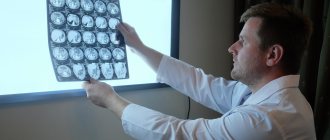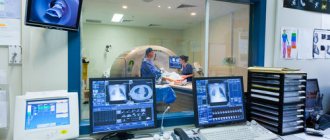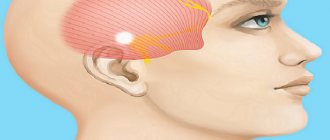How tomography is performed
Magnetic resonance imaging is a unique examination method in which high-power radiation passes through the patient's body. The patient is placed on a special table that enters the scanner through a tunnel. When turned on, a huge magnet is launched. It produces rays through the cavity of internal organs and soft tissues. Sensitive sensors capture the movements of particles and ions, translating them into high-quality images.
MRI is often prescribed for diseases that require accurate diagnosis for final decision-making:
- oncological tumors;
- cerebrovascular disorders;
- abnormalities of the heart and coronary vessels;
- pathologies of internal organs (spleen, liver, kidneys);
- aneurysms;
- fistulas or dangerous abscesses on the mucous membrane of organs;
- distant metastases.
In some situations, MRI is the only way to correctly diagnose and assess the danger of the growth of a malignant tumor. But how do you get an MRI exam if you have claustrophobia? A specific disorder limits the capabilities of a person who cannot remain motionless in the tomograph tunnel.
What is claustrophobia?
Claustrophobia is the fear of enclosed spaces. According to statistics, claustrophobia is the most common phobia on the planet. According to the latest data, about 5% of the world's population suffers from it. Often the causes of certain phobias are stressful situations. Claustrophobia is no exception. Panic can seize a person in any small, enclosed space: a room, an elevator, a storage room, etc. There have been cases when claustrophobia manifested itself for the first time when the patient underwent magnetic resonance imaging.
How does claustrophobia manifest itself?
The main symptoms are identical to other anxiety conditions and nervous disorders. The pulse and breathing quicken, and the person is seized with anxiety. He wants to escape from this room. If panic takes over a person's mind, he may begin to behave aggressively. Such people, when entering any room, stay close to the exit and leave the room first. It is easier for them if the room has windows and open doors. If the patient has to be in a confined space and cannot leave it, the feeling of anxiety increases significantly. MRI examinations for patients with claustrophobia are not the only difficulty. It is difficult for people with this disease to be in:
- elevator;
- airplane;
- by train;
- bus and other public transport;
- toilet;
- a crowd of people (a crush will 100% give rise to a severe panic attack).
Can claustrophobia be cured?
- Contact a specialist. Perhaps the severity of your illness is insignificant, and you can cope with it on your own, but only after receiving the advice of a specialist. The doctor will tell you about special exercises and how they should be performed. Prescribe medications and justify their use.
- An effective way is hypnosis. Usually this is a whole course of sessions. Hypnosis should only be performed by a qualified psychotherapist.
- Treatment with fear is one of the necessary methods. Until you conquer your fear, it will accompany you. Artificially create a stressful situation. Let someone help and support you.
- Another effective method is the modeling method. The goal of this method is to make it clear to the patient that his fear is groundless.
Psychiatrists have various methods for treating claustrophobia. If you contact a specialist, he will definitely find one that will help you.
How to cope with claustrophobia before an MRI?
Claustrophobia is a contraindication to MRI. There are situations when it is impossible to replace the magnetic resonance imaging method with another diagnostic. So how do you get rid of claustrophobia during an MRI? There are several tricks for getting an MRI if you have claustrophobia:
- Take a mild sedative if your phobia does not have pronounced symptoms.
- If the MRI machine is a tunnel type, then remember that there are no barriers to exit at both ends.
- Consider the entire space of the room that is visible from the device. This will let you know that it is not closed.
- Ask the specialist performing the procedure to speak with you.
For example, you won’t be able to cope with claustrophobia before an MRI of the abdominal organs quickly, but these methods will help you undergo an important procedure.
What is fear of enclosed spaces?
A mental illness called “claustrophobia” is a condition in which a person experiences panic and anxiety when entering a confined space. For such people, a banal elevator ride or being in a small room becomes a problem. At an advanced stage of the disease, the patient cannot get on a bus or get into a car.
Fear of enclosed spaces has characteristic features:
- a feeling of severe anxiety increases;
- pulse quickens, blood pressure rises;
- loss of body control;
- sweating;
- feeling of dryness in the throat;
- pain in the temples, dizziness.
Claustrophobia is often an acquired condition. A person faces a dangerous disease after suffering stress, disaster or physical trauma. Some patients manage to control themselves and can enter the elevator for a short time. But conducting an examination using tunnel-type devices takes at least 20–30 minutes, which is too long for a patient with a similar problem.
MRI doctors note that while in a tomograph, a panic attack sometimes begins in a person who has not previously shown signs of claustrophobia. Perhaps the monotonous buzzing and flickering of sensors, new sounds and the need to remain motionless for half an hour have a strong impact on the psyche. An aggravating factor is anxiety in anticipation of a diagnosis, fear of cancer, or poor health due to the underlying illness.
For such patients, it becomes a problem how to get an MRI if claustrophobia prevents them from being in the tomograph tunnel. In some situations, doctors try to choose a gentle method of examination, using radiography or ultrasound. If standard diagnostics do not give the desired result, different methods are used to correct the situation.
Symptoms of claustrophobia
An attack of claustrophobia can be triggered by any form of enclosed, cramped space with limited sources of natural light (for example: an elevator, plane, train, toilet stall, closed parking lot, road tunnels, storage rooms) or large crowds of people (being in a crowd, crowded public transport). For a claustrophobe, discomfort can be caused by any situation in which his freedom of movement is limited or there is no light source. In this case, the person experiences a panic attack, dizziness, cough, dry or sore throat, numbness in the limbs, increased heart rate, profuse sweating and trembling throughout the body. Severe forms of claustrophobia may be accompanied by fainting or semi-fainting, loss of orientation in space, sharp pain in the chest, and frequent urge to go to the toilet.
| Service | Price according to Price | Discount Price at Night | Price by Discounts During the Day |
| from 23.00 to 8.00 | from 8.00 to 23.00 | ||
| MRI of the brain | 3300 rub. | 2490 rub. | 2990 rub. |
| MRI of the pituitary gland (without contrast) | 3300 rub. | 2490 rub. | 2990 rub. |
| MRI of brain vessels (arteries) MRI of neck vessels (arteries) | 3300 rub. | 2490 rub. | 2990 rub. |
| MRI of the paranasal sinuses | 2900 rub. | 2490 rub. 2100 in the sun | 2990 rub. 2100 in the sun |
| MRI of one of the spine sections (cervical, thoracic, lumbosacral, coccyx, craniovertebral junction) | 3300 rub. | 2490 rub. | 2990 rub. |
| MRI of one of the joints (shoulder, elbow, knee, ankle, sacroiliac joints) | 4000 rub. | 2990 rub. | 3490 rub. |
| MRI of the hip joints | 5000 rub. | 2990 rub. | 3490 rub. |
| MRI of the brain and cerebral vessels | 6600 rub. | 4980 rub. | 5980 rub. |
| MRI of three parts of the spine | 9900 rub. | 6800 rub. | 7800 rub. |
| MRI of the central nervous system (MRI of the brain, MRI of the cervical, thoracic and lumbosacral region) | 13200 rub. | 9290 rub. | 10790 rub. |
| Appointment with a neurologist | 1800 rub. | free after MRI | free after MRI |
| Appointment with an orthopedist | 1800 rub. | free after MRI | free after MRI |
| Contrast administration (based on patient weight) | from 3000 to 5000 rub. | only during the daytime | from 3000 to 5000 rub. |
How to get an MRI if you have claustrophobia
Before conducting an MRI examination, the radiologist explains in detail to the patient the rules and features of the procedure. When a tunnel-type device operates, the table enters the scanner cavity, and the tomograph itself rotates around the body. During this time, it is necessary not to move so that the sections are of high clarity without shadows or blurry areas. Sometimes you need to comply with the diagnostician’s request and hold your breath.
Claustrophobia and an MRI procedure are difficult concepts to combine. For patient comfort, modern tomographs have pleasant lighting inside: it can be easily adjusted according to the patient’s wishes. A small fan is responsible for the flow of oxygen. The diagnostician carefully monitors the person’s behavior and physical reactions and can stop the operation of the equipment at any time. If there are no contraindications, downloading and full diagnostics takes no more than 30 minutes.
If the diagnosis of claustrophobia is confirmed, it is recommended to undergo the procedure using an open-type MRI machine. These are relatively new tomograph models that do not have sides. They resemble an operating table with a small canopy. But the number of clinics using such scanners is limited. Therefore, diagnosticians try to use psychological methods to reduce the level of anxiety and prevent a panic attack:
- select a comfortable level of lighting inside the device;
- offer thick bandages to cover the eyes;
- remove the headrest to increase space;
- show the structure of the scanner, which is open from the head and legs.
Some radiologists recommend bringing a loved one with you to the MRI, whose voice and support can help cope with a panic attack. In addition, the patient must know that he is in control of the situation: when the panic button is pressed, the examination immediately stops.
Adviсe
You can partially get rid of claustrophobia before an MRI using psychological influence. You yourself must verify the safety and harmlessness of the method. Read the information about how the procedure goes, and you will come to the conclusion that there is nothing to be afraid of. We ourselves create panic and provoke a phobia.
A detailed self-analysis or a visit to a psychologist can overcome the fear of an MRI. The right attitude will help cope with claustrophobia. Think about what you are more afraid of: examination due to a closed space or test results.
How to alleviate the patient's condition during the procedure
Doctors recommend to patients: if claustrophobia is confirmed, get an MRI using a sedative. Sometimes a light dose of an antidepressant is enough so that the patient can endure a complex examination with a reduced feeling of anxiety.
The following tips can help alleviate the condition:
- in the evening before the procedure, you should get enough sleep and take a relaxing bath;
- watch a video showing the principle of operation of the tomograph;
- visit a treating psychologist or psychiatrist;
- use self-hypnosis to normalize the condition.
In a number of patients, a panic state occurs only when a number of factors coincide. Therefore, diagnosticians sometimes suggest trying to undergo an MRI without anesthesia, trying to reduce the scanner operating time as much as possible.










